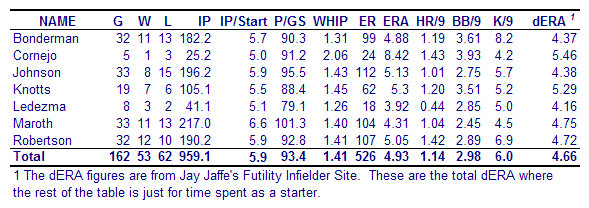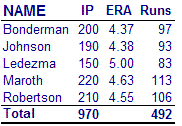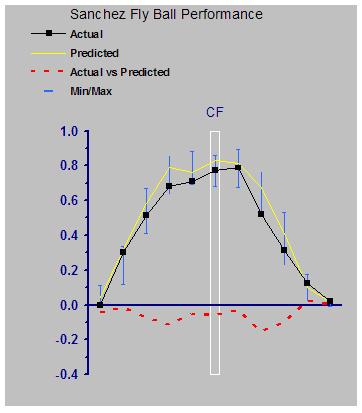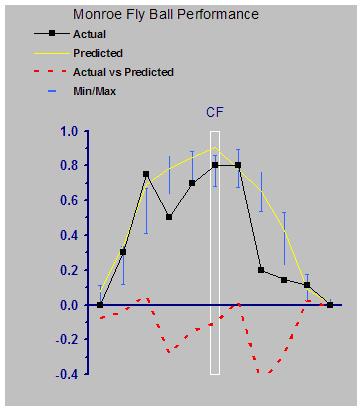With only a couple of weeks until the start of the regular season, it is time to starting doing some previews. I’m going to start this year with the starting rotation for the simple reason that it is the most resolved. There are still question marks regarding outfield configuration (which effects the offense) as well as how to cram 8 pitchers into 6 bullpen slots. However, barring injury, we know that Jason Johnson, Jeremy Bonderman, Mike Maroth, Nate Robertson, and Wilfredo Ledezma will be in the starting rotation.
Similar to last year, I’ll be projecting the total runs scored/runs allowed for the team, and then using the pythagorean theorem to guess a won-loss record. These projections of course will be nothing more than guesses based on past data and gut instinct. However, by tying it all together with a formula at the end I get to present it with a false sense of validity.
Now on to the rotation…
The review before the preview
The one thing you could say about the starting rotation last year is that they were healthy. Johnson, Maroth, Bonderman, and Robertson made 33, 33, 32, 32 starts respectively. This was probably partly due to luck, and partly due to Trammell and Cluck’s vigilant watch of pitch counts. Only two times last year did a starter exceed 120 pitches.
As you may remember, Robertson was only a starter candidate breaking camp last year. However, some early season success earned him the gig full time. The final spot in the rotation was Nate Cornejo’s for 5 starts before a torn labrum ended his season. Gary Knotts occupied Cornejo’s spot for 19 starts before giving way to Wil Ledezma mid season.
Here’s how the starters fared last year:

As a group the starters generally made it through six innings. Maroth consistently pitched into the seventh, while Ledezma was a little bit on the lighter side (due more to protecting his arm than anything else). The starters pitched 70% of the team’s innings, which is pretty much in line with the rest of the league (70.7%). And while their starters ERA ranked 9th in the AL, they were 7th in K/9, 5th in K/BB, 5th in OPS against, and 6th in WHIP. None of the numbers are stellar, but the group probably deserved more than the 53 wins they earned. The starters were clearly hurt by a porous defense and lackluster bullpen.
Now it’s time to look forward…
Jeremy Bonderman
Aside from the general health of most of the team, Bonderman’s continued development is the key to this team contending. At the tender age of 22, Bonderman saw his K/9 jump from 6.0 to 8.2 while his homers decreased. His walk rate rose (3.22 to 3.61 per nine), but due to his bigger jump in strike outs, his K/BB ratio still improved.
Bonderman’s fastball averaged 93.3 MPH last year, yet he relied more on his knee buckling slider to fool hitters. A change-up is still in development to give him a third pitch.
Bonderman finished the season like a Cy Young candidate last year. Unfortunately, it came after some pretty significant struggles that had people wondering whether he should be in the minors, let alone starting. He’s still young, and will still have those struggles. However, I think they’ll be fewer and farther between. I think he’s a good bet to improve on his 4.37 DIPS ERA and he should top 200 innings while flirting with 200 strike outs. Using the 4.37 DIPS as a proxy for the combination of his improvement and the Tigers poor defense that would equate to 97 runs in 200 innings.
Jason Johnson
Johnson was bad last year. He had a couple of spectacular performances, one against Johan Santana and his opening day blanking of the Jays. But the year as a whole was a struggle. Early on he battled blister problems. Later in the year he battled fatigue.
Fatigue is perenially an issue for Johnson. It could be due to his diabetes, his workout regimine, or just something he is susceptible to. Over the last 3 years he is 1-10 in September. When he hits the 91 pitch mark in games his OPS against shoots up to .889. For these reasons, he is never going to be an innings eater.
Despite the 5.13 ERA last year, Johnson improved pretty much every other statistic over the year before. His strike outs were up, walks were down, and homers were down slightly. His OPS against was virtually identical. He also became much more of a groundball pitcher with a 1.68 GB/FB ratio against a career average of 1.15. All of this should have spelled success (or at least decent-ness). It’s for this reason, that I think Johnson’s production will improve this year – simply out of luck. Again using DIPS from last year, and applying it to 190 innings that would equate to 93 runs. An improvement of 19 runs over last year.
Wilfredo Ledezma
Ledezma is the wildcard in the Tigers rotation. He has a ton of potential, he has demonstrated it successfully at AA Erie, and to a lesser extent at the big league level. Last year was the first year in his career he topped 84 innings at any level. His K/BB rate wasn’t particularly impressive last year. However, his ability to fling the ball at 93-94 MPH is. Because of his youth, I expect inconsistency. Because of his limited experience, I’d expect no more than 150 IP. Because Ledezma is such an unknown, I really hope the Tigers can find a way to keep Gary Knotts around as insurance. That being said, I love Ledezma’s upside.
My projection on him is even sketchier than my other ones. I’ll say 150 IP at a dERA of 5.00 which is between league average and replacement level. That would be 83 runs allowed. I really think that Ledezma can pitch better than that. Whether or not he does, and does so this year, remains to be seen.
Mike Maroth
Mike Maroth is probably the best pitcher the Tigers have. He doesn’t have the “stuff” that the others guy do. He has the 4th slowest fastball in the AL (85.5 MPH) and routinely threw pitches less than 80 MPH (846, 4th most in the AL). However, he does the most with what he has, and as a southpaw will be able to turn that into a long career.
Despite boosting his strike out rate 10% to 4.48, Maroth doesn’t strike out enough people. However, he did significanly reduce his home run rate, allowing 9 fewer dingers in 24 more innings. His dERA of 4.75 is slightly below the league average of 4.63. And there’s nothing wrong with trotting out an average left hander for 220 innings a year. If Maroth continues to pitch like an average pitcher that would be 113 runs allowed.
Nate Robertson
While there was lots of talk about the break out years of Guillen, Inge, and Infante, Robertson’s was probably right on par with his offensive teammates. He started the year competing for a spot in the rotation, and ended up pitching 195 innings. His K rate north of 7 is very reassuring. His next task for this year is to whittle down the home run rate. Like Johnson, he struggled in the second half of the season and he was routinely hit hard after the All Star break.
If he can reclaim some of his early season success and sustain it, it is reasonable for him to improve to league average or slightly above. He’s 27, so we may be seeing his best over the next two to three years. I’m going to pencil him in at 210 innings and a 4.55 dERA (marginally above average). The result is 106 runs.
Summary
If the Tigers are going to improve to the point of contention this year, a lot of that improvement will have to come from the development of the starting rotation. The lineup is better, the bulllpen is better. The question is whether or not what we saw last year from these young pitchers is their peak, or if there is still room to grow. Overall, my projections have the staff at a modest improvement with 30 fewer runs in a few more innings pitched.

As for how the rotation stacks up in the Central, I see it probably as 3rd to 4th best with a chance to be second best. The Tigers can’t compete with the top two of the Twins (Santana, Radke) or the White Sox (Garcia, Burehle), and even to a lesser extent the Indians (Sabathia, Millwood). And when it comes to established levels of performance, the Twins and White Sox are certainly better. However the Tigers have youth on their side, and while I don’t think they can match the Twins they could certainly meet or pass the White Sox. Similarly, I see question marks in the Indians rotation as well. If Westbrook can build on last year and Cliff Lee can come through the Indians could have a very respectable rotation as well.
Now the credibility of these projections is certainly questionable. I haven’t factored in injuries at all, and I’ve shown quite a bit of improvement. Also, projecting pitcher ERA’s is probably fruitless anyways. I tried to mitigate that a bit by using dERA. But while dERA may be a decent predictor of subsequent dERA, it really doesn’t tell you a whole lot about how many runs might actually score (see Jason Johnson last year). All that being said, it is still a fun endeavor and I encourage all of you to leave your projections in the comments as well. As for sources, I of course used Jay Jaffe’s DiPS information. The pitch speed information was from the Bill James Handbook. All the splits were from different internet sources (ESPN.com, Baseball Reference, Sports-Wired).




